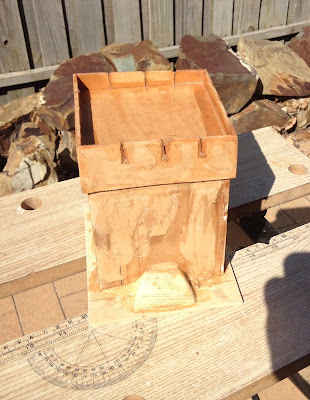With the new shooting and elimination rules in place (jotted down on a note pad) and with a few final tweaks based on comments received from my last post, it was time to test the rules out.
 |
| British line up for battle |
A very quick recap of the rules with their modifications.
When shooting units roll a number of dice (D6) depending the unit type and hitting on 4+ regardless of whether the target unit is in cover.
Artillery and Light Infantry and Frontiersmen roll 1D6
Line Infantry, Grenadiers and Militia roll 2D6
Cavalry roll 3D6 when charging
Once a unit has exceeded the limit of hits allowed they are eliminated. However, a unit's staying power is increased by 2 when they are in cover.
Militia - 4 hits in open and 6 hits in cover (Militia get cover when in fenced fields and buildings)
Artillery - 4 hits and 6 hits in cover (fortifications only)
Frontiersmen - 4 hits in the open and 6 hits in any cover
Cavalry - 5 hits
Light Infantry - 5 hits in open and 7 hits in any cover
Line Infantry - 6 hits in open and 8 in cover (buildings only)
Grenadiers - 7 hits in open and 9 hits in cover (buildings only)
Having decided hills would not increase a units staying power. Any unit shooting down from a hill is allowed to re-roll one failed to hit dice. This deliberately helps artillery and skirmish type units more so than line infantry.
So on to the game - the battle of Reynold's Farm...
Turns 1 and 2
The American commander started the game with a resolve of 6 having gained 2 resolve points with holding the farm and one on the hills. American forces decided to hold the farm and nearby fields placing their militia units in fields to benefit with an increase staying power (6). Their other forces made a flanking move on the British left flank.
The British for their part quickly raced to hold the two hills to their centre and left flank. Gaining 2 commander resolve points (resolve = 6).
Note - hills and building squares when occupied increase a commanders resolve being key terrain features.
 |
| American forces deployed and in the background they start their flank move |
Turns 3 and 4
The British force was surprised by the speed of the American flanking move and came under some ineffective fire from their artillery. The hill on their left flank was shaping up to be the crucible of the coming battle.
 |
| American forces can be seen moving up on the British left flank |
Turns 5 and 6
British and American forces had deployed a good portion of their forces around the hill and were exchanging volleys of fire. While the British artillery were finally deployed.
 |
| Volleys being exchanged between sides |
Turns 7 and 8
Units on both sides were suffering hits, but neither side had yet lost any units. While American artillery was focused on the hill, British artillery was firing upon their counterparts with a good level of accuracy delivering a number of hits.
 |
| The view of the battle from Reynold's farm |
Turns 9 and 10
Both sides started to suffer unit casualties. The British losing a line infantry unit and the light infantry on their left flank. This quickly drew the cavalry reserve into the battle to shore up the left flank. The American forces lost an artillery unit and line infantry.
The commander resolve of both sides was reduced to 4 a piece. Note - commander resolve is reduced by one whenever one or more units are lost during a turn.
 |
| British cavalry move in to shore up their left flank |
Turns 11 and 12
While American forces continued to be lost in the attack upon the hill, the British grenadiers were lost in its defence. Meanwhile on the left flank the remaining British forces had started to advance upon the farm buildings.
 |
| The American attack starts to wane as casualties take their toll |
Turns 13 and 14
With the attack losing momentum and British advancing upon Reynold's farm, addition loses saw American command resolve reduced to 1. British resolve was only fractionally better sitting at 2, but their remaining units in better condition the tide of battle was now definitely in their favour.
 |
| The American attack finally crumbles |
Turns 15
The American commander concedes and the remaining units retire.
The rule changes appear to work ok and need some more games to be tested, but they will remain for the present and will need to be written up. My next task in the coming weeks.



















































